![]()
![]()
![]()
Use LEFT and RIGHT arrow keys to navigate between flashcards;
Use UP and DOWN arrow keys to flip the card;
H to show hint;
A reads text to speech;
47 Cards in this Set
- Front
- Back
|
What is heterotrophic ossification? What is the hint to help remember this? |
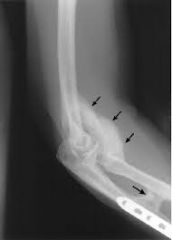
[Image] Heterotrophic ossification is the formation of bone in strange places.
Hint: hetero- means "different". |
|
|
What is rheumatoid arthritis? |
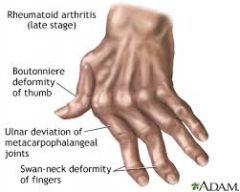
[Image] Rheumatoid arthritis is a systematic (i.e. methodical) and progressive condition. Rheumatoid arthritis flows to many joints, especially the HANDS. |
|
|
What does the root word -rheum (r.h.e.u.m.) mean? This makes up the word rheumatoid. |
"rheum" (r.h.e.u.m.) itself is a Greek word that means "flow." The word was first ascribed to the disease of rheumatism because of the way it seemed to spread — or flow — within a patient's body. |
|
|
Rheumatoid arthritis: There are 3 deformites common to rheumatoid arthritis. Describe the one that is not Boutonniere Deformity or Swan Neck Deformity |
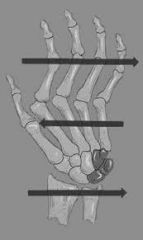
[Image]
Ulnar deviation or ulnar drift and subluxation of wrists and MCP joints. |
|

Rheumatoid arthritis: Describe Boutonniere's Deformity. |
![Boutonniere Deformity is P.I.P. flexion & D.I.P. hyper-extension.
[HINT: Fingers positioned to adjust boutonniere flower, or if closed, to hold pin to pin it on.]](https://images.cram.com/images/upload-flashcards/30/15/35/9301535_m.jpg)
[Image] It is P.I.P. flexion & D.I.P. hyper-extension. [HINT: Fingers positioned to adjust boutonniere flower, or to hold pin to pin it on.] |
|

Rheumatoid arthritis: Describe Swan Neck Deformity. |
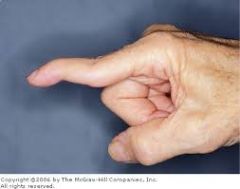
[Image]
Swan Neck Deformity is hyper-extention of the PIP, flexion of the DIP. |
|
|
What is osteo-arthritis? |

[Image] Osteoarthritis is a degenerative joint disease resulting from WEAR & TEAR. Commonly affects large, weight bearing joints. |
|
|
Joints of the hand: Name the abbreviations and full names for them. |
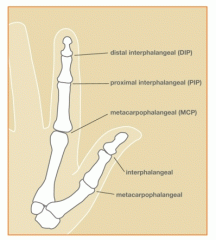
[Image] 1. D.I.P. is distal inter-phalangeal joint. 2. P.I.P. is proximal inter-phalangeal joint. 3. M.C.P. is meta-carpo-phalangeal joint. |
|
|
Name the bones of the hand. |
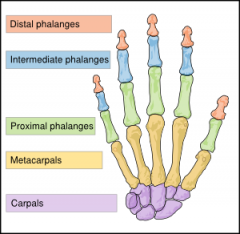
[Image] 1. Phalanges. Including distal, intermediate, and proximal. 2. Meta-carpals. 3. Carpals or carpal bones. |
|
|
Amputation. Wrapping of residual limbs.
What is the proper way to wrap a residual limb and why? |
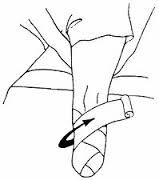
A limb should be wrapped diagonally. This keeps the limb from having circulation cut off. |
|
|
Amputation. Wrapping of residual limbs.
Why is it done and when should a limb have wrapping on it? |
Wrapping a residual limb keeps it from swelling and fits it for prosthesis.
A limb should be wrapped at all times. |
|
|
Amputation. Describe the nomenclature for the levels of amputation. |
1. Forequarter, which is the loss of clavicle, scapula, & entire upper extremity. 2. Disarticulation, which is the separation of 2 bones at the joint (like the wrist, elbow, hip, knee) 3. Trans, like trans-femoral, trans-humeral, trans-radial, and trans-tibial. 4. Finger amputation |
|
|
Amputation. What does treatment for the residual limb consist of? (One thing.) |
Treatment of the residual limb consists of desensitization as well as other really cool stuff. |
|
|
What is R.L.P. stand for? |
R.L.P. stands for residual limb pain. |
|
|
What is residual limb pain (R.L.P.)? |
R.L.P., or residual limb pain, is the pain that originates in the remaining part of your limb. (This is not Phantom limb pain.) |
|
|
What is phantom limb pain? |
Phantom limb pain is a sensation of pain perceived to originate from a body part that, in reality, is not there. |
|
|
What's another name for Total Hip Replacement? |
Another name for "Total Hip Replacement" is "Total Hip Arthroplasty". |
|
|
What are the types of "Total Hip Arthroplasty"? |
There are two types of "Total Hip Arthroplasty", as follows:
1. Total Hip Implant. Here they replace both the acetabulum and the femoral head.
2. The Austin Moore, or Partial Hip Replacement. Here they replace only the femoral head. |
|
|
What are the total hip precautions for a Total Hip Replacement? |
The total hip precautions for a Total Hip Arthroplasty are: 1. No flexing beyond 90 degrees. 2. No adducting or crossing legs. 3. No rotating hips, meaning don't point your toes inward or outward. ALSO: 4. No pivoting at the hips. 5. Sit only on a raised chair and toilet seat. 6. Transfer sit to stand by keeping the operated hip in slight abduction and extended out front. |
|
|
C.O.P.D. What does it stand for? |
C.O.P.D. stands for Chronic Obstructive Pulmonary Disease. |
|
|
What is C.O.P.D. and what is it caused by? |
C.O.P.D. is a lung disease that makes it difficult to breathe. It is caused by damage to the lungs over many years, usually from smoking. |
|
|
C.O.P.D. is usually a mix of what 2 diseases and describe those diseases? |
C.O.P.D. is usually a mix of chronic bronchitis and emphasema.
1. Chronic bronchitis is the airways that carry air to the lungs get inflamed and make a lot of mucus. This can narrow or block the airways, making it hard to breathe.
2. Emphasema is when the air sacs in the lung are damaged and lose their stretch. Less air gets in and out and makes you feel short of breath. |
|
|
What is the etiology of hip fractures? |
The etiology of hip fractures includes the following: 1. Trauma to the hip. 2. Osteoporosis. 3. Pathological fractures, for example from cancer. 4. More. |
|
|
What are the types of hip fractures? |
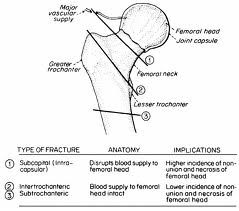
[IMAGE.] The types of hip fracture are. 1. Femoral neck fracture. 2. Inter-trochantric fracture. 3. Sub-trochantric fracture. |
|
|
What is the medical management of hip fractures and define all the parts of your answer? |
Hip fractures are medically managed in 3 ways: 1. Closed reduction. This is for minimally displaced fractures & is done without surgery. 2. O.R.I.F. Open reduction internal fixation. Open means surgery, reduction means returning the bone to its proper place, internal fixation means the bone is fixated to something internal. 3. Joint replacement. |
|
|
Hip fracture. What are the precautions? |
The precautions for hip fracture are determined by the surgeon. This includes the weight bearing status, amount of ROM, and when to begin OT. |
|
|
Edema. How is it best treated? |
Edema is best treated with elevation and A.R.O.M. |
|
|
Tell me about shingles and what does it look like? |
Shingles, or Herpes Zoster, is characterized by vesicular eruption. It looks fairly like psoriasis. It can last 10 days to 5 weeks. Pain may persist for months. |
|
|
What is phantom limb pain? |
Phantom limb pain is pain experienced in a body part that is no longer there.
Phantom limb sensation is far more common. |
|
|
What is referred pain? |
Referred pain is pain that is perceived in part of the body when the source of the pain is in another part of the body. |
|
|
What are C.T.D., or cumulative trauma disorders, and name 3 examples of them? |
Cumulative trauma disorders are are a group of repetitive strain injuries. 3 examples are: 1. DeQuervains. 2. Epicondylitis, either lateral or medial. 3. Trigger finger. |
|
|
What is deQuervain's disease? |
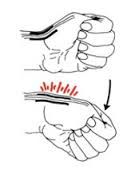
Image. . A painful inflammation of tendons in the thumb that extend to the wrist. Swollen tendons & coverings rub against their narrow tunnel. The result is pain at the base of thumb, extending into lower arm. HINT: the quer wrist. |
|
|
What is the technical term for tennis elbow and what is it? |
Tennis elbow is lateral epicondylitis. This is an irritation through overuse of the wrist extensors. |
|
|
What is the technical term for golfer's elbow? |
Golfer's elbow is medial epicondylitis. This is over use of the wrist flexors. |
|
|
What is trigger finger? |
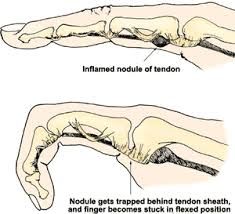
IMAGE. HINT. is obvious. Trigger finger is tenosynovitis of the finger flexors, especially the first. It's caused by repetition. |
|
|
What is carpal tunnel syndrome? |
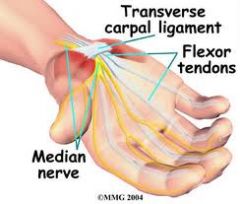
Image. Carpal tunnel syndrome is pain, tingling, and numbness in the hand (but not the pinky) that is a result of pressure on the median nerve. |
|
|
Name the nerves of the hand and what areas they are associated with. |
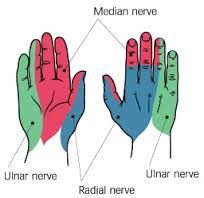
Image. The names of the nerves of the hand are median, ulnar, and radial nerves.
Please look at image for areas. |
|
|
Burns. What are the names of the different kinds of burns? |
To replace the old terms of 1st, 2nd, & 3rd degree burns, the terms are now superficial, partial thickness, and full thickness. Partial thickness was divided into 2, as follows: 1. Super-ficial burn. 2. Super-ficial partial thickness burn. 3. Deep partial thickness burn. 4. Full thickness burn. |
|
|
What is a superficial burn? |
A superficial burn used to be called 1st degree burn. It's the equivalent of a light burn with a curling iron. It involves only the superficial aspect of the skin organ, which is the epidermis.
There is minimal pain and edema, and there are no blisters. They heal in 3 to 7 days. |
|
|
Yo slappy, what is a partial thickness burn? |
A partial thickness burn is a 2nd degree burn. They are burns that extend down to the second layer of skin. into the dermis. (So they effect the epidermis and the dermis.) There are 2 kinds of partial thickness burns. superficial and deep. |
|
|
What is a superficial partial thickness burn? |
A superficial partial thickness burn is a more superficial 2nd degree burn. Its a burn that affects the superficial level of the second layer of skin, the dermis. It's red, blistering, and wet. It heals in 7 to 21 days. This would be a sunburn. |
|
|
What is a deep partial thickness burn? |
A deep partial thickness burn is a deep 2nd degree burn. It affects deep into the dermis and affects hair follicles and sweat glands. They are red, white, and elastic. They take 3 to 7 weeks to heal. |
|
|
What is a full thickness burn? |
A full thickness burn is a 3rd degree burn. In addition to the epidermis, dermis, hair follicles and sweat glands, this burn type effects nerve endings. They appear white, waxy, and leathery. There is no pain and skin grafts are required. Healing can take months. |
|
|
What is a 4th degree burn? |
A 4th degree burn involves fat, muscle, and bone. There is destruction of nerves along the pathway. Rule of nines is a method of assessing burn wound size. |
|
|
What is the rule of nines and what are its components? |
The rule of nines has the following measurements:
The head and arms are 9% each. The torso is 36%. The legs are each 18%. The pubic area i s1%
|
|
|
When a hand is burned and requires splinting, describe the position of the hand. (This doesn't include splinting for a burn on the volar, or palmer, surface of the hand, which is different.) |
1. the wrist in 20 to 30 degree extension. 2. MCP joints in 50 to 70 degree flexion. 3. IP joints in full extension. 4. Thumb abducted and extended |
|
|
Describe the position of a splinted hand that was burned on the volar side. |
The volar side is the palmer side. (Picture a Volare car in palm of hand with guy singing that song.) 1. Wrist in 0 to 30 degrees extension. 2. MCP joints in neutral and abducted. 3. IP joints in full extension. 4. Thumb abducted and extended.d |

